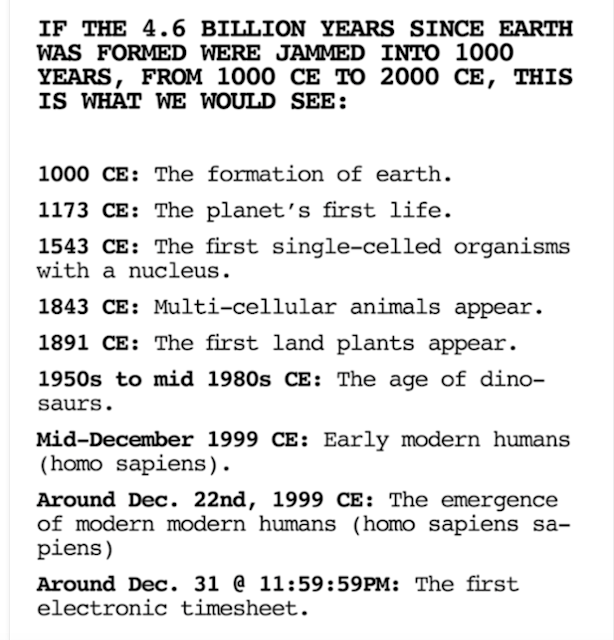1. There are the "that will change everythings." And,
2. There are what I call the "tectonics."
Group 1 seems to believe that every new technological doodad, hairstyle, pop-song, or hamburger topping is the great new new thing and will forever alter (or will alter for six weeks) the world in fundamental ways.
There were a lot of Group 1-ers at digital agencies. They believed Google+, or myspace, or Microsoft Vista, or some new design or UX wizardry would be the secret to fame and success. They might still be doing the Harlem shake.
Group 2, of which I am a fervent member, are those who believe in the persistence of a core of human behaviors--behaviors that take literally hundreds of thousands of years to change.
I believe that the same elements that made Homer's Iliad and Odyssey listen-to-able 6000 years ago, are the same elements that make movies watchable, books readable and tv-shows bingeable today. As Pulitzer-winning historian Barbara Tuchman once said, "the persistence of normal is strong." Group 2-ers claim Bernbach as a founding member. He said, "advertising should be based on ‘simple, timeless, human truths.’”
I believe that the same elements that made Homer's Iliad and Odyssey listen-to-able 6000 years ago, are the same elements that make movies watchable, books readable and tv-shows bingeable today. As Pulitzer-winning historian Barbara Tuchman once said, "the persistence of normal is strong." Group 2-ers claim Bernbach as a founding member. He said, "advertising should be based on ‘simple, timeless, human truths.’”
But there's more, I've realized than this dichotomy. I've been thinking about this for a while and what I've come to is what I believe is a similar schism to the one I've described above when it comes to time.
Last week, if I were writing this, every news story, every late-night-monologue joke, and half the conversations in America were about the spectre of either alien-invasion or Chinese-invasion because the Strategic Air Command, or Norad, or Fox News noticed a two-bus-sized balloon floating over the continental United (sic) States.
This week, as they used to say, stories about balloons are back with the shipping news.
Balloons are no more. I'm not even sure Party City has any balloons in stock anymore. They've vanished like 48-year-olds at a holding company agency.
If you spend any time with history, not just the Edict of Nantes, Norman invasion history kind of shit, but even larger history, like the actual development of earth and the formation of life and the geology of our planet, you'd realize that your sense of time is very different from the modern 'Breaking News' sense of time.
Change isn't measured merely in 'day-parts' or even millennia. It's measured in ages. Literally hundreds of millions of years.
In advertising, over the last ten years, the word 'culture' has been tossed around like a volleyball on the beaches of Santa Monica.
We have to be a part of culture.
We have to influence culture.
We have to move at the speed of culture.
Forget about the bias in that use of the word culture. It assumes that your culture is the same as my culture and that your culture is right, relevant and for all. Forget about that.
What's really happening here is another dichotomy. In Cartesian terms (if I can put Descartes before the horse) we have another grand subject-object split.
We have the Group 1-ers who are chasing culture and trends. They think two weeks is 'time,' a long time.
And the withering number of Group 2-ers. Who think commercial messages based on unchanging values and humanity are necessarily more enduring and, therefore, more valuable. They think twenty-thousand years is 'time.'
This is not to say I believe in ignoring the world around us. It is time, however, I think to pose a bigger industry-wide question. A question, I think, CMOs might also want to think about.
"Are we doing work for the next quarter?
Or are we doing work for the next quarter of a century?"
Or are we doing work for the next quarter of a century?"
Obviously, we have to "drive sales overnight and build brands over time." So we have to be both in the here and now while having respect for those behaviors and beliefs that unite humanity. The lasting ones. Like respecting people. Like not shouting.
When I was six, my parents took my brother and sister and me out to the New York World's Fair in Flushing Meadow Park, in Queens, New York. (BTW, the fair was built on what F. Scott Fitzgerald called in the Great Gatsby, 'The Valley of Ashes.' Trillions of dumpings of centuries of New York's incinerator waste.)
My father must have given us each fifty-cents and for the first and maybe last time in my life, I got to do a carnival attraction called 'spin-art.' You know, where a small piece of paper rotates at a high-speed and you squeeze paint on it.
Back in 1964, I thought my spin-art creation superior to anything at the Met or the Louvre or the Hermitage or even anything by Jeff Koons, who isn't much older than I am.
Today, you can't look at spin-art without getting slightly nauseous and feeling slightly stupid, not to mention ridiculously dated.
A lot of what we do in marketing today, I'm afraid, is spin-art. It lasts about 12-seconds.
I'm working for ideas with a bit more longevity. Something that could speak to humans, like this well-bronzed guy below. He's 2,500 years old.
He looks pretty good to me.
Even if he is NSFW.




No comments:
Post a Comment